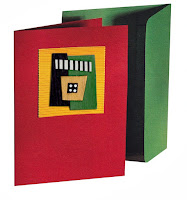Learn about the fundamentals of card design.
Greeting Card Sales Stats
Greeting Card Design Tips
Things to avoid in Card Design
Greeting Card Association Artist Guidelines
You know you are a greeting card designer when…
 Starting a Card Business
Starting a Card BusinessLearn how to manufacture and sell your cards to retail stores.
How to Present Your Card Line
Test Marketing Your Card Line
Getting Your First Greeting Card Account
Getting Professional Feedback on Your Card Line
Pricing Your Cards
Pricing and Profits: The Tale of 2 Greeting Card Businesses
Good News for Indie Card Artists: New Sales Trends
Online Class: Design and Sell Your Own Cards
Starting a Card Line on Your Own
Backcopy:What to print on the back of your cards
List of Books on the Greeting Card Business
Book Review: How to Run a Greeting Card Business
Book Review: Pushing the Envelope
Setting up Card Ordering Codes
All About Envelopes
Greeting Card Quiz: How much do you know about the industry?
Ginger McCleskey, Greeting Card Rep, Talks about Trends
Greeting Card Buying Statistics
Marketing Cards
Learn how to market cards.
12 Unusual Ways To Market Your Greeting Cards
List of Trade Shows for Greeting Card & Gift Designers
How to Sell Art Through Social Media
List of Trade Magazines for Card and Gift Industry
How to Use Email to Sell Art & Get Leads
How to Sell Designs Online: Jude Maceren
Venues for Selling Greeting Cards Online
How to Find Greeting Card Sales Reps
The Handmade Card Business
Learn how to run a thriving handmade card business.
How to make a living in the Handmade Card Business
How to Set Up a Handmade Card Factory
Making Cards: Questions to Ask
Simplify Card Making for a Profit
Paying People to Make Your Cards
3 Parts of a Greeting Card
8 Advantages of the Handmade Card Business
Interview with Former Greetings etc. Editor, Kathy Krassner
Handmade Greeting Card Business Directory
Card Writing
Learn How to Write Greeting Card Sentiments.
Meet the Master of Greeting Card Writing
Audio Interview: Getting into the Greeting Card Writing Market
How Poets Can Write Greeting Card Verse
Interview with Hallmark Card Writer
Artist & Writer Submission Guidelines for Card Companies
Breaking into the Greeting Card Writing Market
How to Write Greeting Card Verse (VIDEO)
7 Mistakes Card Writers Make
Licensing Your Designs to Companies
Learn how to license your designs to publishers.
Submission Guidelines for Card Companies
How to Mail Promos of Your Designs to Card Companies
How to Organize Greeting Card Submissions
How to get Started in Art Licensing
How to Make a Good "Art Licensing Website."
How to Deal With Rejection: Tips for Card Designers
Resources on Greeting Cards and Licensing
Greeting Card Licensing Information from the UK
List of Licensing Agents in the US
Support
Learn how artists manage their time and set goals.
How to Make Time for Art
How to Start a Buddy Meeting System
How to Start an Art Licensing Support Group














































